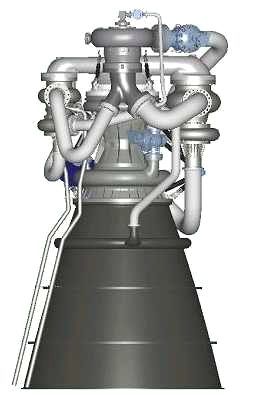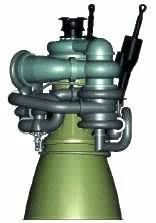
Home - Search - Browse - Alphabetic Index: 0- 1- 2- 3- 4- 5- 6- 7- 8- 9
A- B- C- D- E- F- G- H- I- J- K- L- M- N- O- P- Q- R- S- T- U- V- W- X- Y- Z
RS-84
 RS-84 Credit: NASA |
Status: Development ended 2005. Date: 2002. Thrust: 5,159.00 kN (1,159,789 lbf). Specific impulse: 335 s. Specific impulse sea level: 301 s. Height: 4.67 m (15.32 ft). Diameter: 2.74 m (8.98 ft).
The RS-84 was the Boeing Rocketdyne Lox/Kerosene design for NASA's Space Launch Initiative. The design borrowed extensively from Russian technology developed in the forty years since the USA began its last such design, the F-1. The engine featured a high-pressure chamber and staged combustion cycle in comparison with the F-1's lower pressure chamber and gas generator. Another requirement was to produce the first US reusable Lox/Kerosene engine. This made it necessary to limit the kerosene temperature while cooling the thrust chamber, and limit soot build-up in the turbine. To accomplish this the RS-84 included an arrangement of small section manifolds along the combustion chamber and engine nozzle. These manifolds were spaced so the kerosene was not heated above the coking limit. Some manifolds also injected a small amount of kerosene directly into the thrust chamber to create film wall cooling. The oxygen-rich staged combustion used a cleaner, heated oxygen gas to drive the turbine to avoid problems inherent in kerosene-rich gas products. On 19 March 2004 NASA announced cancellation of further development of the RS-84.
Objectives of the RS-84 were improved safety (33 failures per million missions), reduced costs ($ 1 million-per-use life cycle cost) and improved operability (10-shift turn time). An oxygen-rich combustion cycle using RP-1 kerosene fuel had been selected by SLI Architectures as the best cycle, due its inherent safety and operability features, and excellent performance and packaging. Objectives of the program were design and test of 1 million pound thrust prototype engine, validation of existing and new analytical tools, and to provide the groundwork for a decision to proceed with full-scale development.
Figures given here are for the ultimate production engine design. The prototype engine would have 4732 kN at sea level; 5026 kN in vacuum; an 8-shift turn time; a specific impulse of 305 at sea level and 324 in vacuum; a dry weight of 8128 kg; a life of 100 missions; and a 20:1 area ratio, length of 3.73 m, diameter of 2.74 m.
Thrust (sl): 4,665.000 kN (1,048,733 lbf). Engine: 6,783 kg (14,953 lb). Chamber Pressure: 177.00 bar. Area Ratio: 36. Propellant Formulation: Lox/RP-1.
Country: USA. Propellants: Lox/Kerosene. Agency: Rocketdyne. Bibliography: 460, 7540.
 | RS-84 |
Back to top of page
Home - Search - Browse - Alphabetic Index: 0- 1- 2- 3- 4- 5- 6- 7- 8- 9
A- B- C- D- E- F- G- H- I- J- K- L- M- N- O- P- Q- R- S- T- U- V- W- X- Y- Z
© 1997-2019 Mark Wade - Contact
© / Conditions for Use